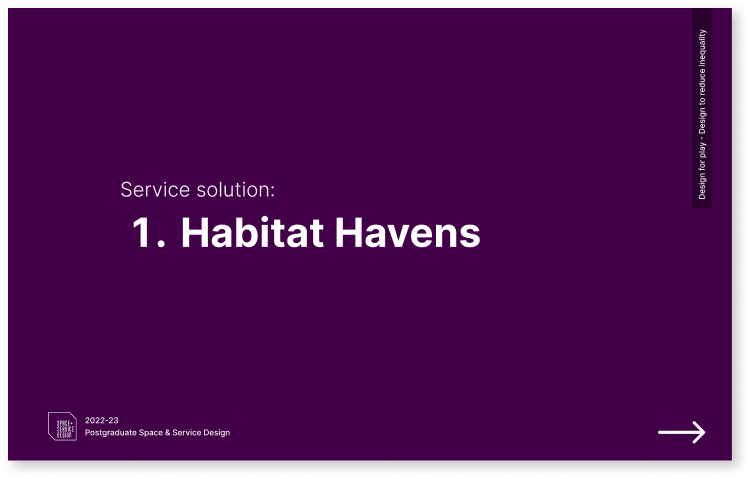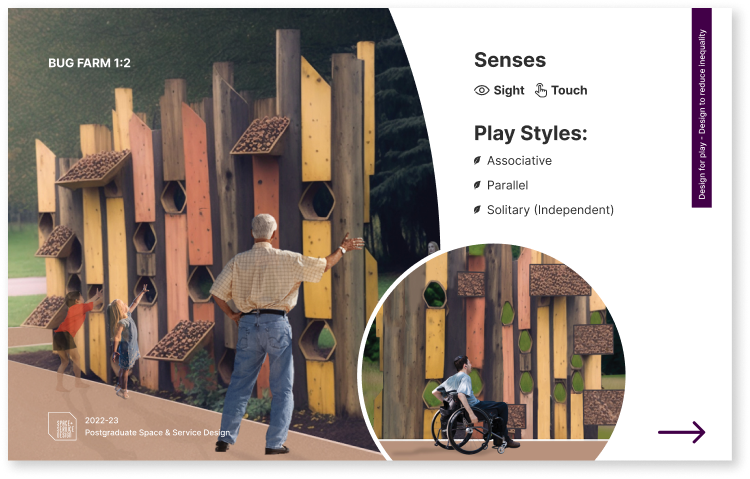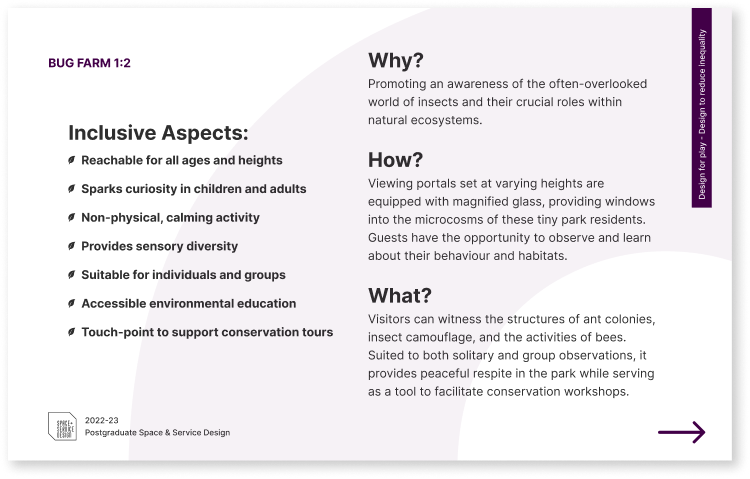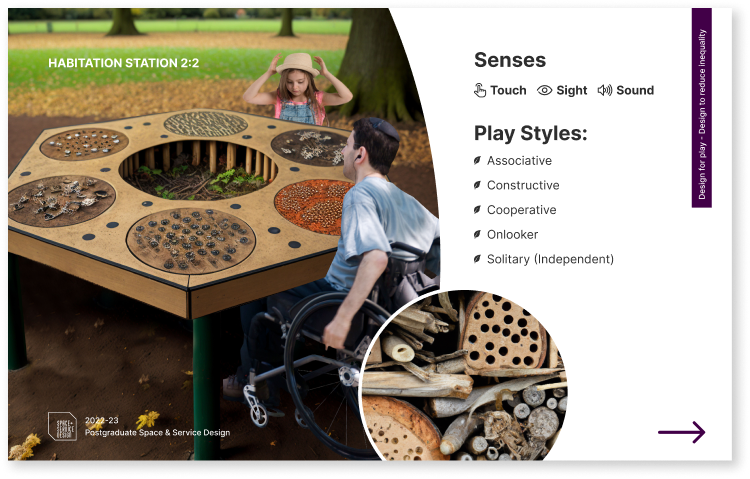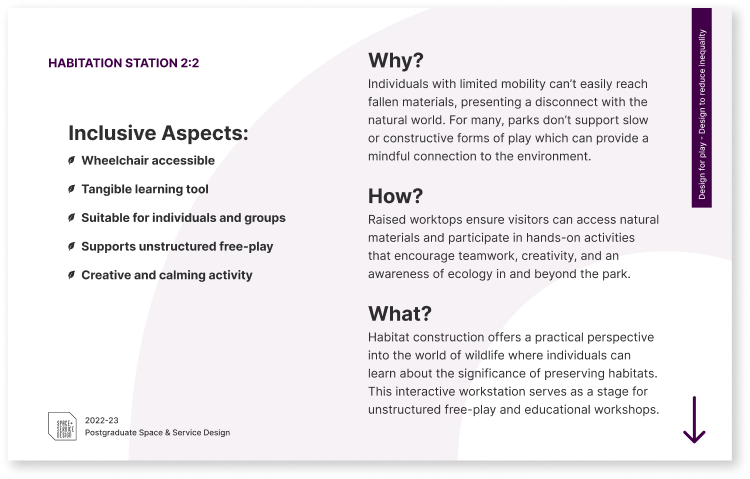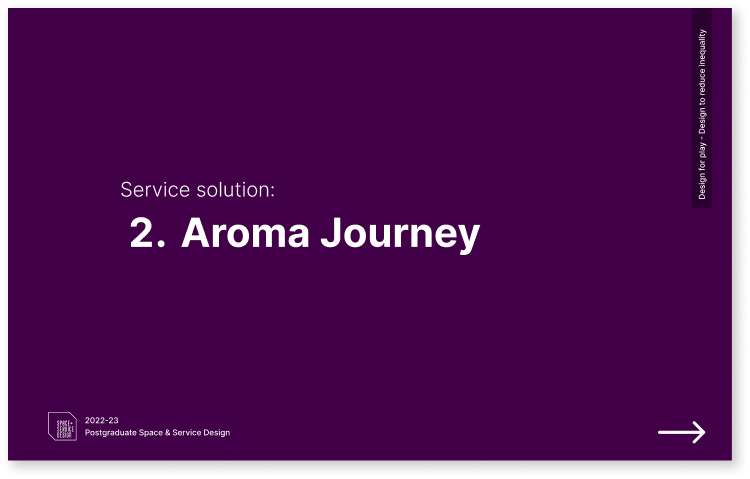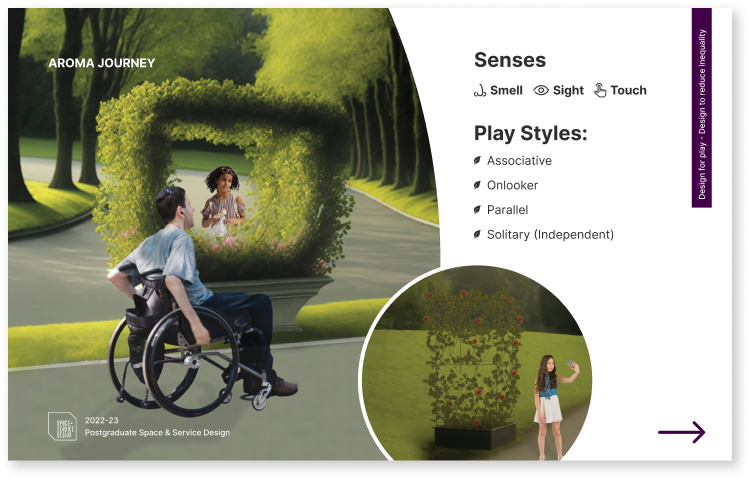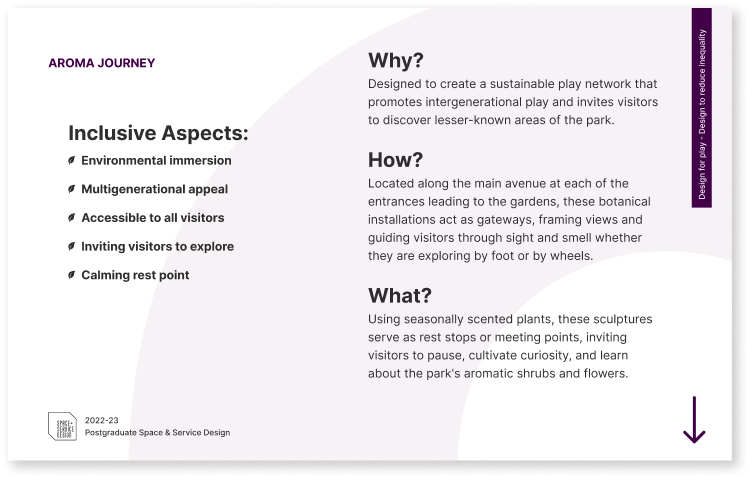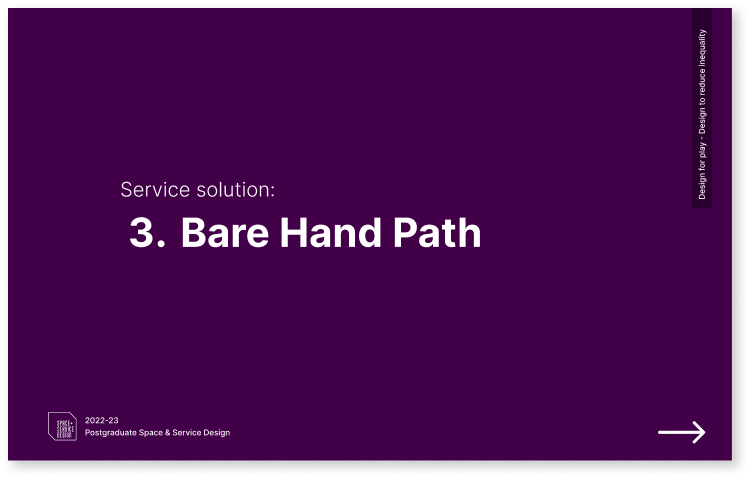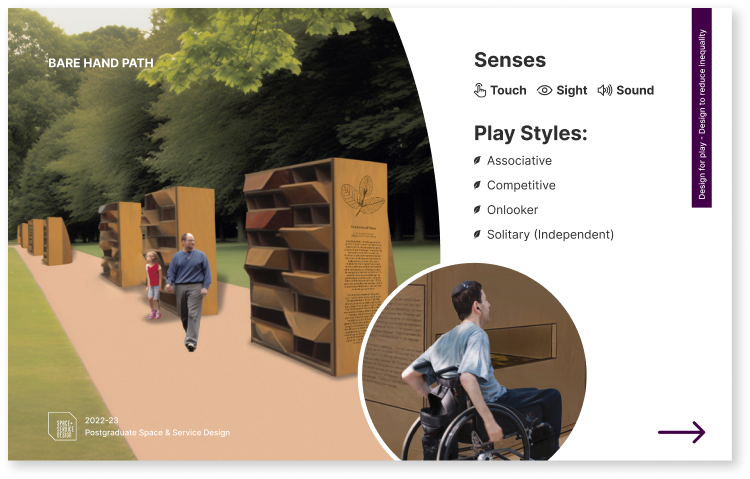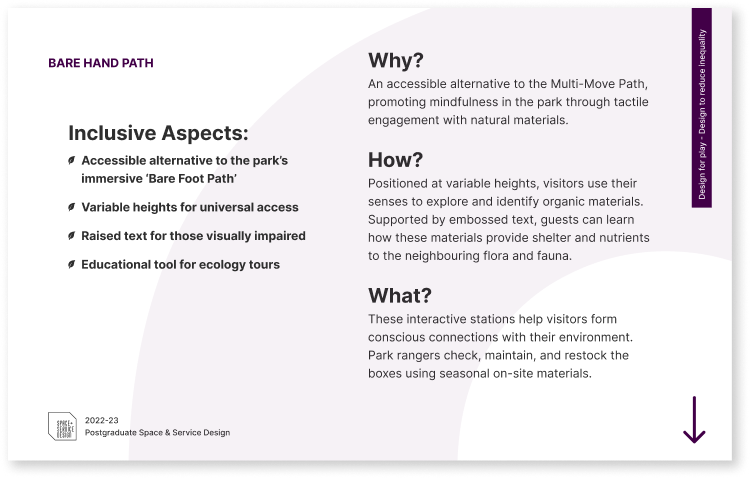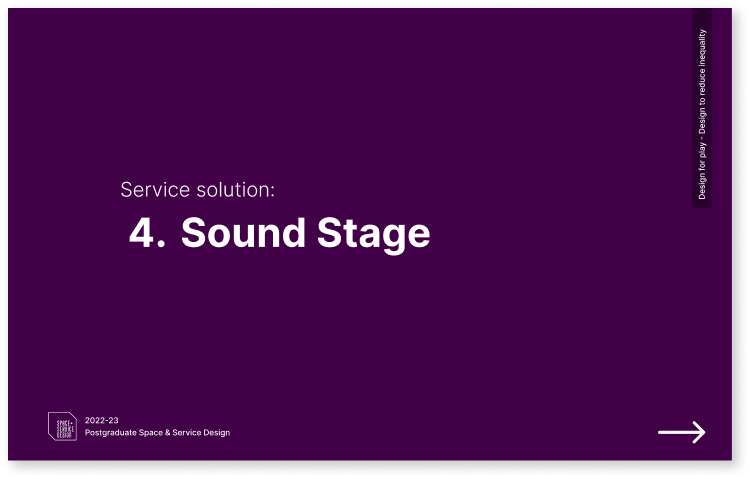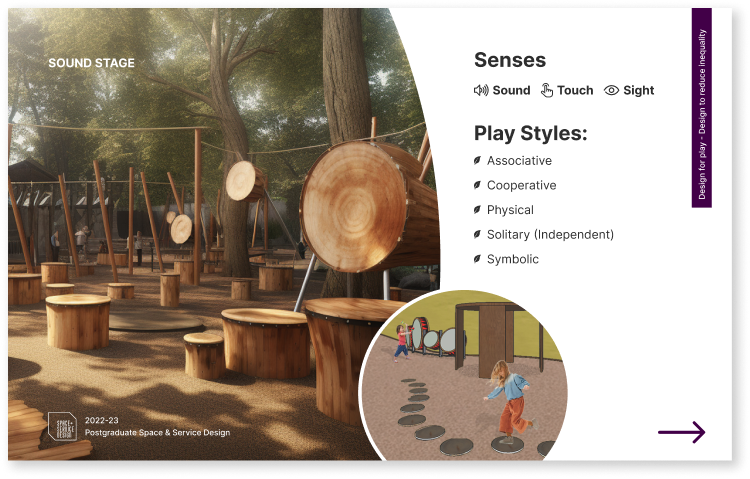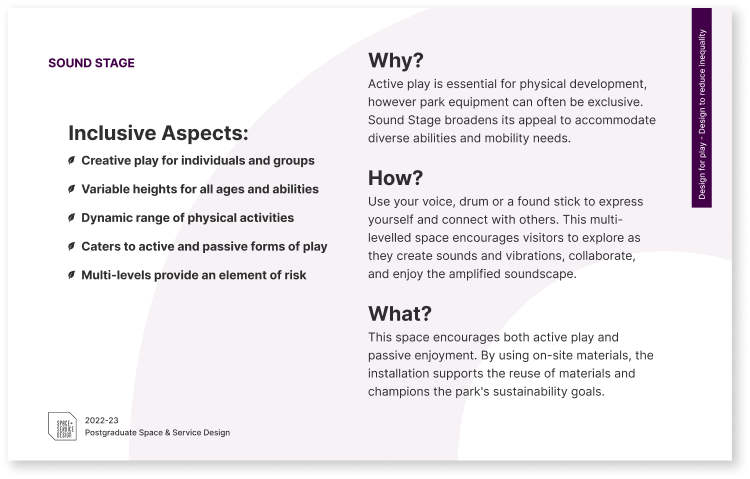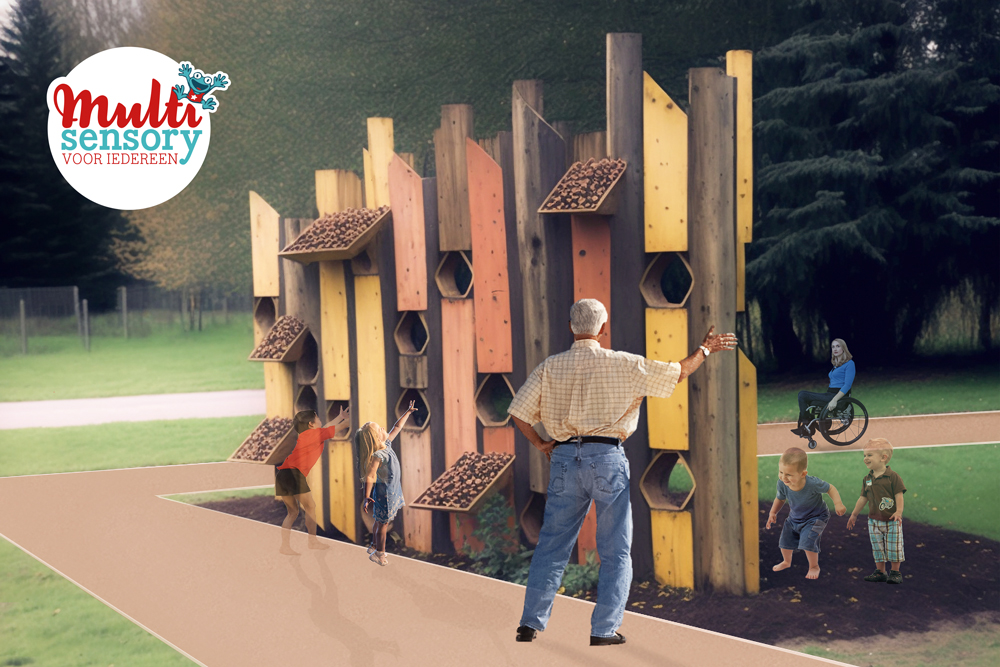

Enabling a more diverse group of visitors to engage with a provincial park and its natural environment through non-discriminatory and immersive experiences.
Context
Postgraduate project • 2022-23 • 17-week duration • Sustainable Development Goal #10
Client
Vrijbroekpark Mechelen in partnership with the province of Antwerp, Belgium.
Teams
Collaborative project supported by course convenors at Thomas More University.
Multidisciplinary teams comprised of interior architects, industrial designers, and graphic designers. Divided into two groups: x3 researchers and x4 designers.
My Role
Service & UX Design • User Research • Visual Design • Copywriting
Vrijbroekpark
A 65-hectare city park located on the edge of Mechelen, Belgium. The historic parkland offers a variety of amenities, natural attractions, and recreational activities to its visitors including walking and cycling trails, playgrounds, sports facilities, gardens, and eateries.
The park aspires to be an inclusive site that welcomes all and is accessible to people without physical or social barriers. A park for families, people from different backgrounds, and with all capacities to learn, play and grow together.
Initial Brief
‘How can services and service touchpoints (spaces, objects, tools, communication tools) enable inclusive play and playing experiences for children and families in public parks?’
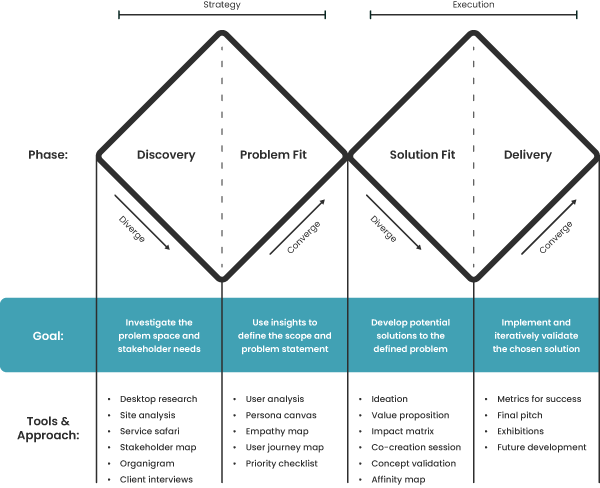
We began by exploring the problem space through primary and secondary research methods including site analysis and engaging stakeholders. We then defined the problem fit using research-led personas, empathy maps, and priority charts to frame our design challenge. During the development phase, we explored potential concepts, collaborated and validated ideas in participatory workshops before analysing the findings. Final delivery included presenting our final pitch to prominent stakeholders followed by public exhibitions. This iterative approach ensured that our process remained rooted in user-centred principles throughout the design journey.
Research Goal & Objectives
The initial meeting aimed to contextualise the park’s history, central functions, underlying principles, and future aspirations. By understanding more about the park’s evolution and core values, we were able to gain a greater awareness of its significance and role within the local community and among its stakeholders.
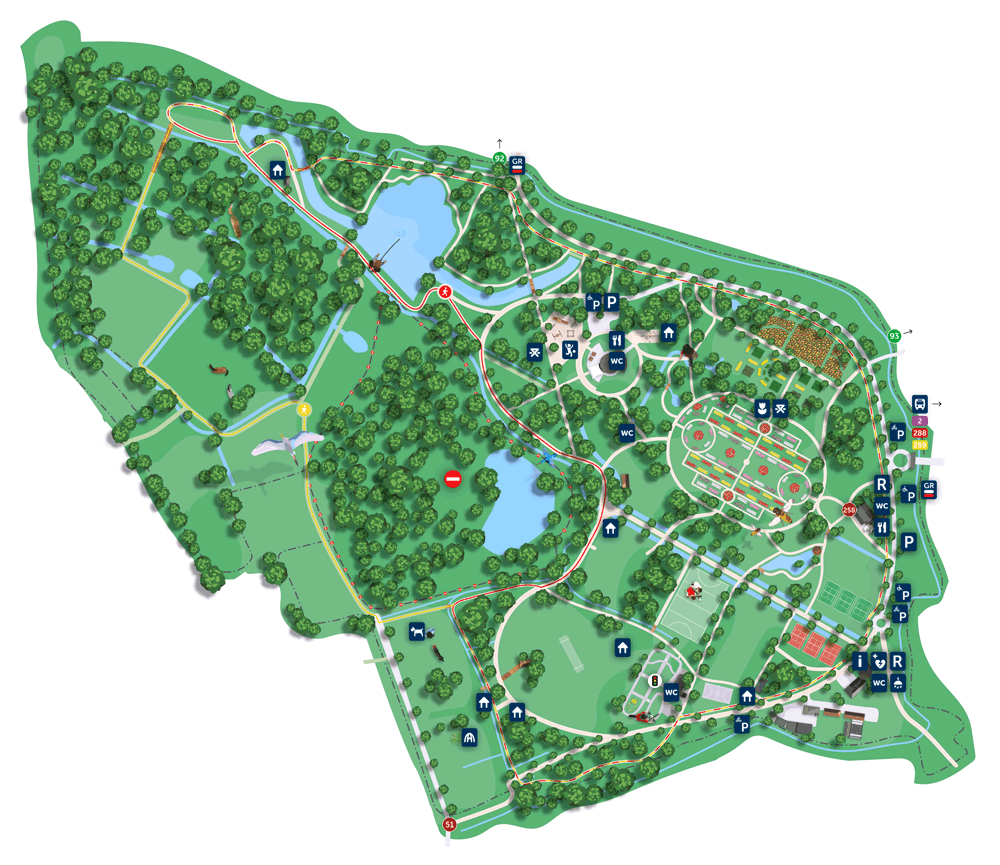
Vrijbroekpark site map
Client Values & Future Vision
Appealing to a more diverse range of visitors
Welcoming to all regardless of barriers
Nature conservation and sustainability
Combining education and play experiences
Developing an on-site play network
Charting existing facilities helped establish a baseline to understand the specific locations and touchpoints visitors interact with. Additionally, this process highlighted the diverse range of available amenities offered within the park, providing insight into user demographics and themes to explore further.
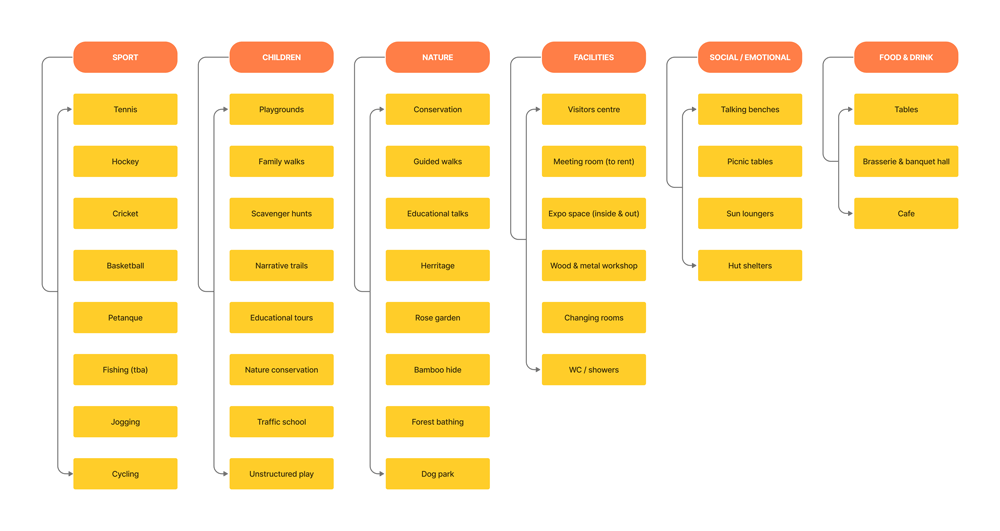
Investigating the play spaces provided a valuable perspective regarding existing play services and aided in discerning currently underserved user groups. While varied in equipment, it was evident that the widely-spread use of sand across the parks posed potential challenges for individuals using wheels, such as wheelchairs, buggies, bikes, or even wheelbarrows. This safety feature presented an immediate barrier for some visitors, making access unlikely and potentially isolating them from participation. Similarly, the equipment appeared to require significant strength and mobility to interact with, likely alienating visitors with limited physical capabilities.
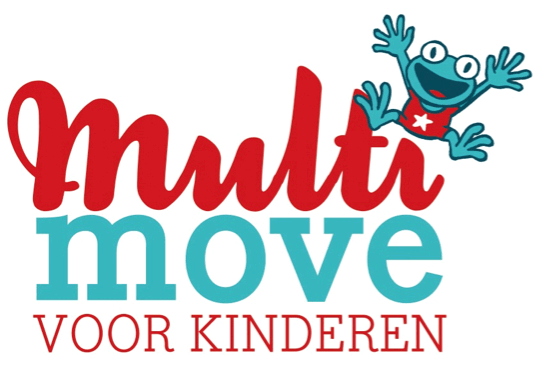
Multimove Voor Kinderen (Multimove For Children), is a varied movement program designed by ‘Sport Vlaanderen’ to promote and nurture motor development in children aged 3-8. Comprised of nine stations with six additional locations scheduled to be built, Vrijbroekpark’s Multimove Path combines this fitness program with play by providing a range of outdoor activities to encourage children to engage with nature and challenge their physical abilities such as balance and risk-taking. While championing outdoor activity and the use of sustainable materials, the unpaved and often uneven tracks throughout the path present limited access to those with mobility restrictions. The stations also demonstrated usability barriers, reliant on full-bodied movements such as climbing and jumping, alienating users with physical impairments and those less intent on active forms of play.
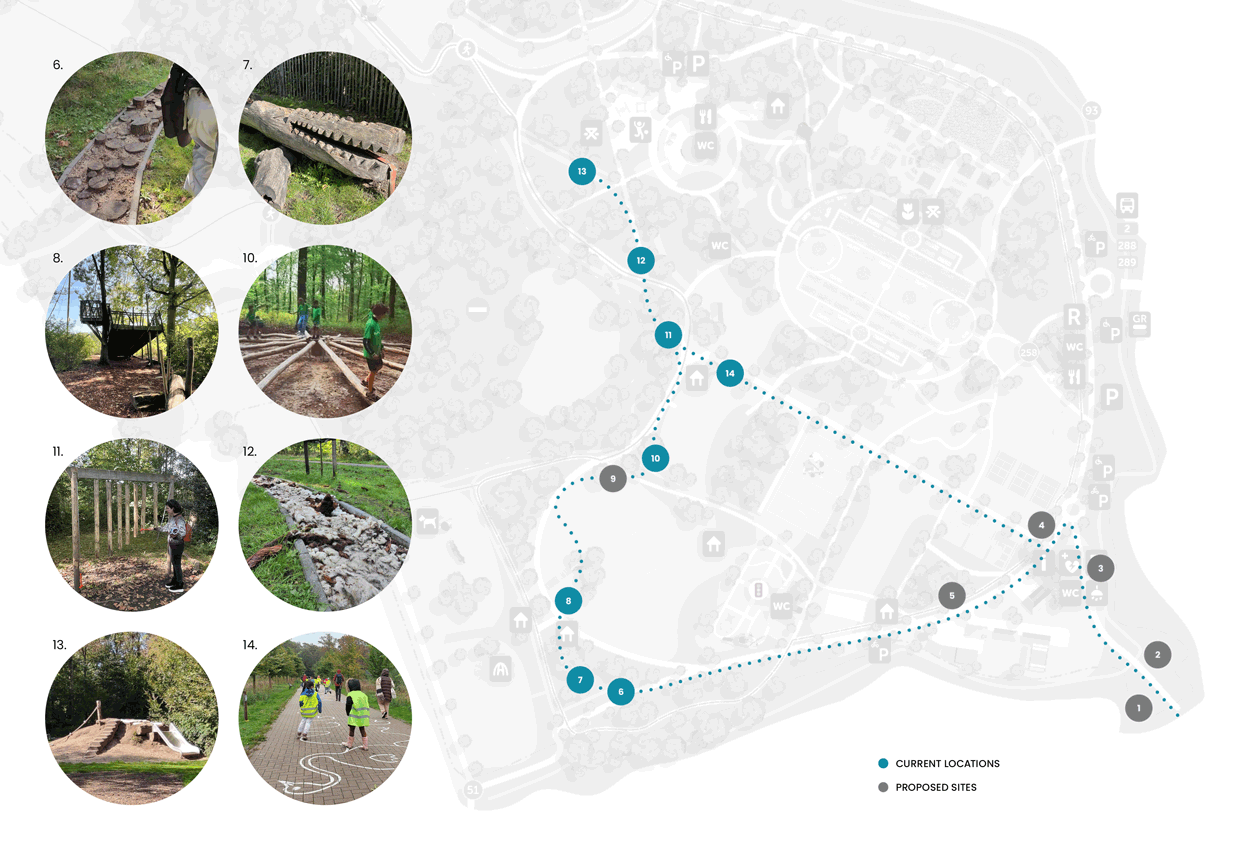

The future vision of the park aims to create a more welcoming and engaging environment for a wider range of visitors, emphasising the importance of inclusivity and diversity considerations. An initial assessment of the park’s current recreational services revealed several strengths contributing to its current value and appeal in facilitating play, such as offering varied and engaging activities that promote physical development and nature exploration. While commendable, they predominantly cater to young, able-bodied individuals, focusing largely on physical forms of play. Nonetheless, an unexplored potential exists for creating inclusive play experiences that ensure universal accessibility and engagement for visitors of all abilities.
Key Findings
Current Strengths:
Improvement Opportunities:
Literature Review
Conducting thorough desktop research guided the team in making informed decisions rooted in research. Topics of investigation included categories of play in child development, the importance of unstructured nature play, identifying needs and barriers faced by under-represented visitors, and exploring various case studies to examine current service solutions for marginalised user groups.
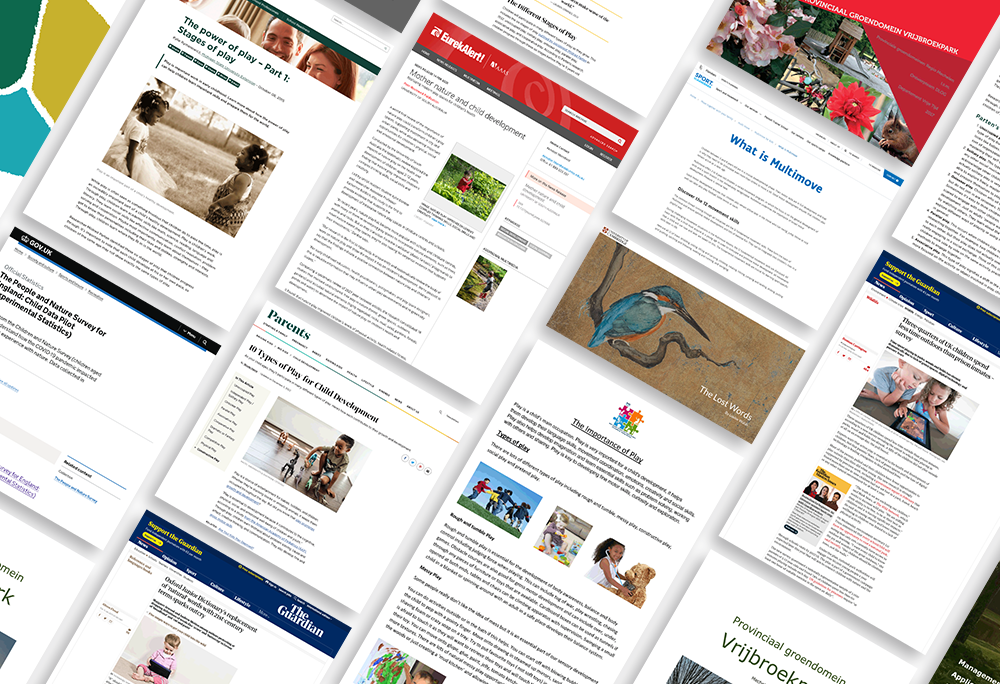
Findings:
“75% of UK children aged between 5-12 spend less time outdoors than prison inmates”
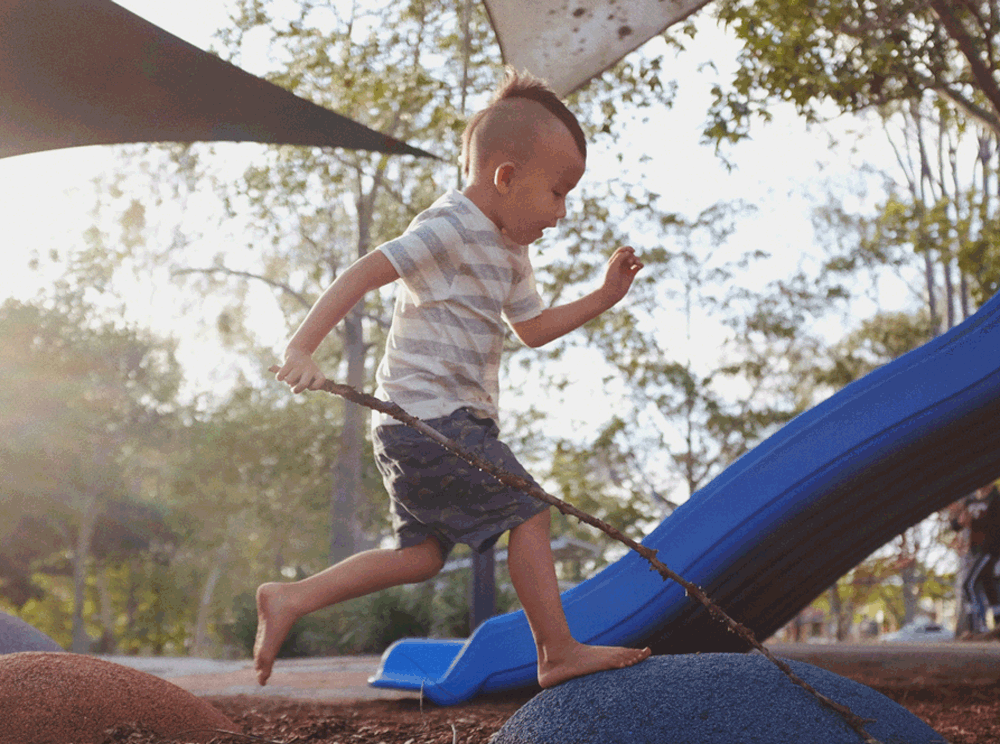

The Oxford Junior Dictionary removed natural words from it’s pages: ‘Acorn’ and ‘Kingfisher’
Forms of Play
Child development encompasses a diverse range of play styles, each contributing to a child’s physical and psychological growth. Physical play through activities like running and climbing can promote motor skills, exploratory play can engage the senses, social play can nurture collaboration skills, and solitary play can strengthen personal independence. While these categories are by no means complete, it’s important for us to understand that styles of play are never rigid, and tailoring future play services to meet varied individual needs, especially for children with impairments or unique requirements, ensures holistic and inclusive development.
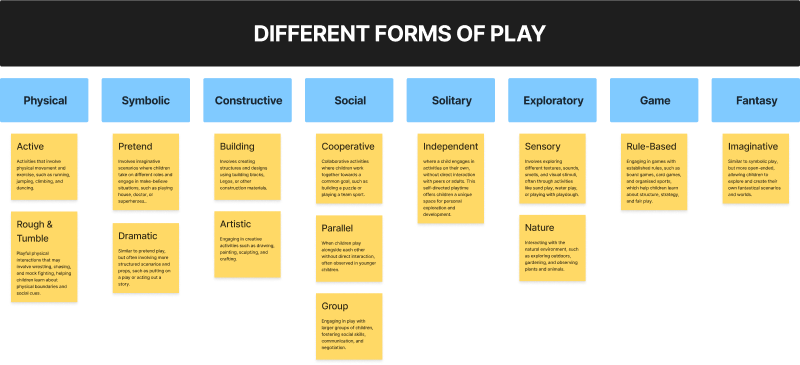
Refers to the type of play where children engage in activities and interactions that are not directed, controlled, or dictated by adults or specific rules. It allows children to explore, create, and use their imagination freely. Unstructured play can take many forms including creative play, construction, drawing, and exploring their surroundings. The key characteristic is that it is self-directed and driven by the child’s interests and curiosity.
Benefits of unstructured nature play:
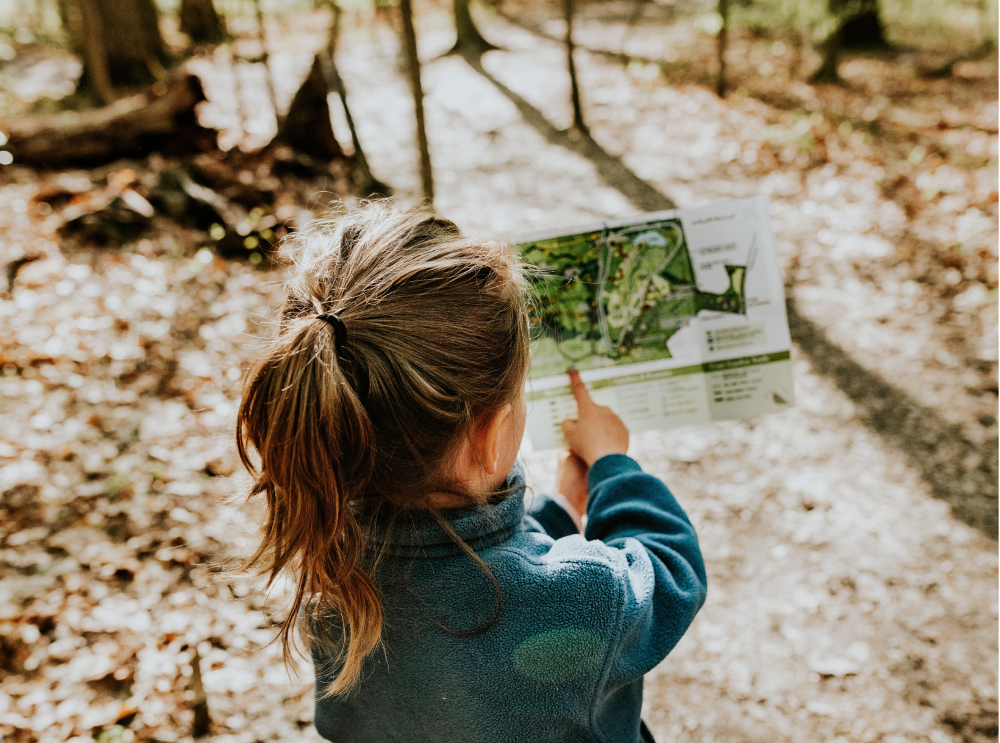
In order to learn more about how the park facilitates educational tours, we observed a park ranger conducting a workshop for a group of 25 primary school students, aged between 8-10. In addition to the ranger leading the session, the group was accompanied by the student’s school teacher, an assisting staff member, and an additional ranger who observed the class for learning purposes. During this workshop, we noted the structure of the lesson from welcoming to departure, site locations, and methods used including service tools and touch-points, along with recording behaviour expressed by students and staff in order to identify potential strengths and pain points.
Themed around insects, the workshop was designed to cater to a range of learning styles utilising a combination of pre-prepared tools, games, and physical installations throughout the park to make the learning experience interactive and engaging. This approach demonstrated the park’s dedication to nature conservation while also providing an enriching learning experience for the students.
Key Findings
Current Strengths
Improvement Opportunities
Problem Space Summary
The park’s current play spaces demonstrate a commitment to championing unstructured play, accommodating diverse play styles that enlist both motor development and multisensory engagement. While nature conservation and the use of sustainable materials play an active role in the park’s values, there appears to be a disconnect between the current services and spaces available with the future vision to support a more diverse range of visitors.
When we examine these potential barriers we are able to identify several underrepresented user groups whose needs are not currently being met. Individuals with mobility restrictions face challenges due to limited access, physically demanding and inappropriate equipment. Visitors who are unable or less inclined to be engaged in active forms of play are excluded from much of the current play facilities, while those outside of the young, able-bodied target demographic also find themselves underserved by the current play provisions, neglecting diverse abilities and ages. Addressing these gaps is crucial to enhance inclusivity and diversity within the park’s play experiences.
Accessibility Workshop
While examining the problem space, we participated in a practical workshop run by INTER, the Flemish government centre for Accessibility. During this session, we used wheelchairs, canes, and visually restrictive glasses to simulate various physical impairments including cataracts; macular degeneration; and tunnel vision, providing us with an appreciation for the unique challenges visitors may encounter while navigating and experiencing the park.
This immersive approach quickly framed the site in a new perspective, highlighting unsuitable play facilities, pathways, and previously overlooked obstacles. It also emphasised the difficulties experienced in off-road navigation, accounting for a significant proportion of the park’s nature trails.
By no means conclusive, this session provided an empathetic snapshot into barriers faced by some individuals, drawing attention to the need for universally accessible and user-friendly solutions.
Accessibility & Impairment Research
In order for us to effectively address and respond to the needs of future visitors, we conducted further research into the behaviour and characteristics of individuals currently underrepresented by the park including those living with autism, mobility constraints, visual impairments, and hearing challenges. In doing so we also explored existing examples of play facilities designed specifically for these user groups to inform our approach.
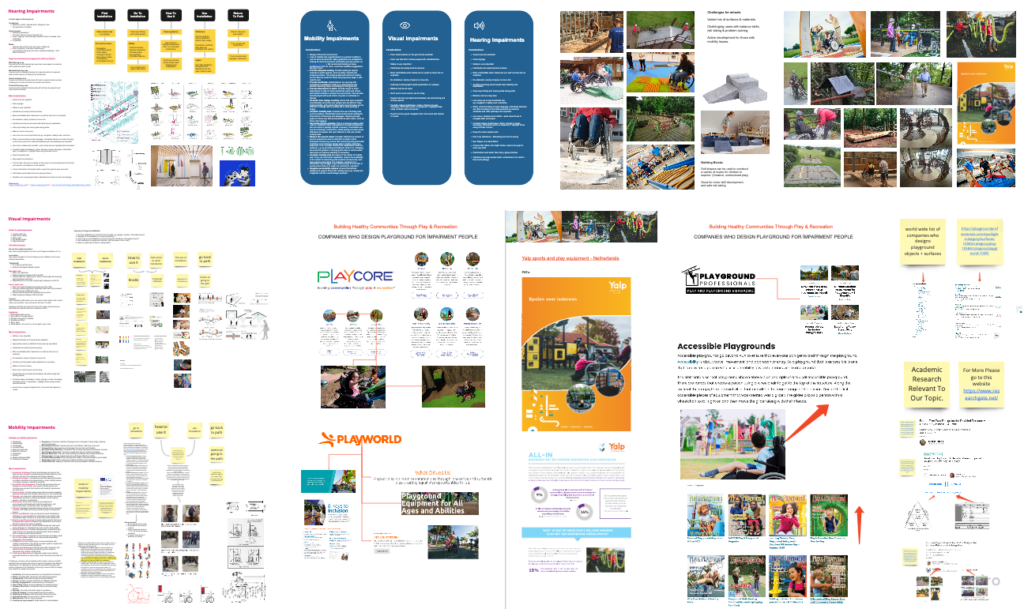
Usability & Physical Access
Play spaces and activities with accessible pathways, sensory elements, and adaptive equipment ensures that individuals of all abilities can participate.
Sensory Diversity
Incorporating a variety of natural textures, sounds, scents, and visual stimuli caters to diverse needs and sensitivities.
Flexible Play Options
A mix of play experiences accommodating both solitary and collaborative activities.
Varying Social Spaces
Providing spaces for group play and quieter spots for individual exploration caters to varying social preferences.
Sustainable Materials
Using materials found in nature, like logs, rocks, and sand, provides opportunities for users of diverse abilities to engage in creative and imaginative play.
Visual & Auditory Signage
Incorporating visual and auditory cues heightens communication and assists individuals in navigating and enjoying the park.
Natural Tranquility
Natural settings can provide a calming atmosphere, benefiting people who wish to embrace mindfulness or require quiet spaces.
Client Interview
Semi-structured interviews were conducted with senior management responsible for project coordination and public outreach. The qualitative data obtained played a vital role in understanding the park’s organisational structure and operational procedures, including decision-making processes and financing. Additional insights assisted in identifying stakeholders responsible for implementing, utilising, and maintaining new services.
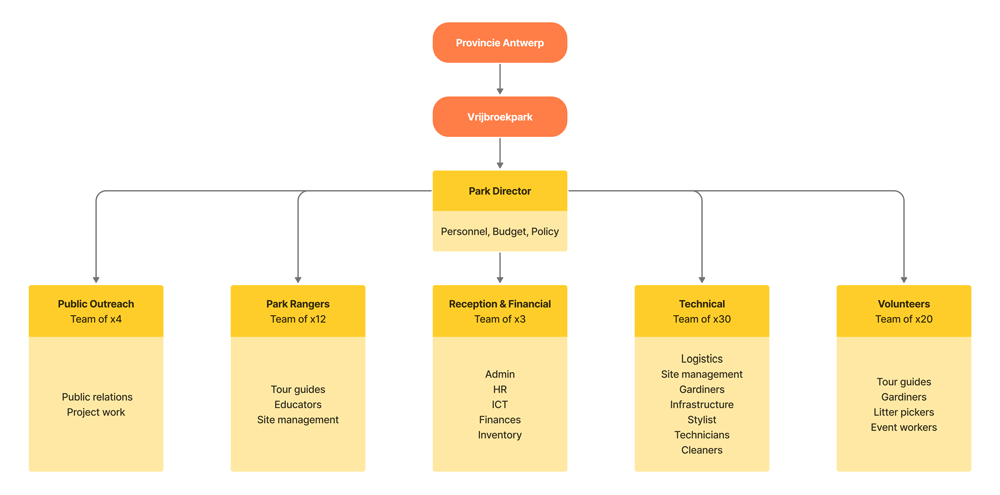
Park organigram.
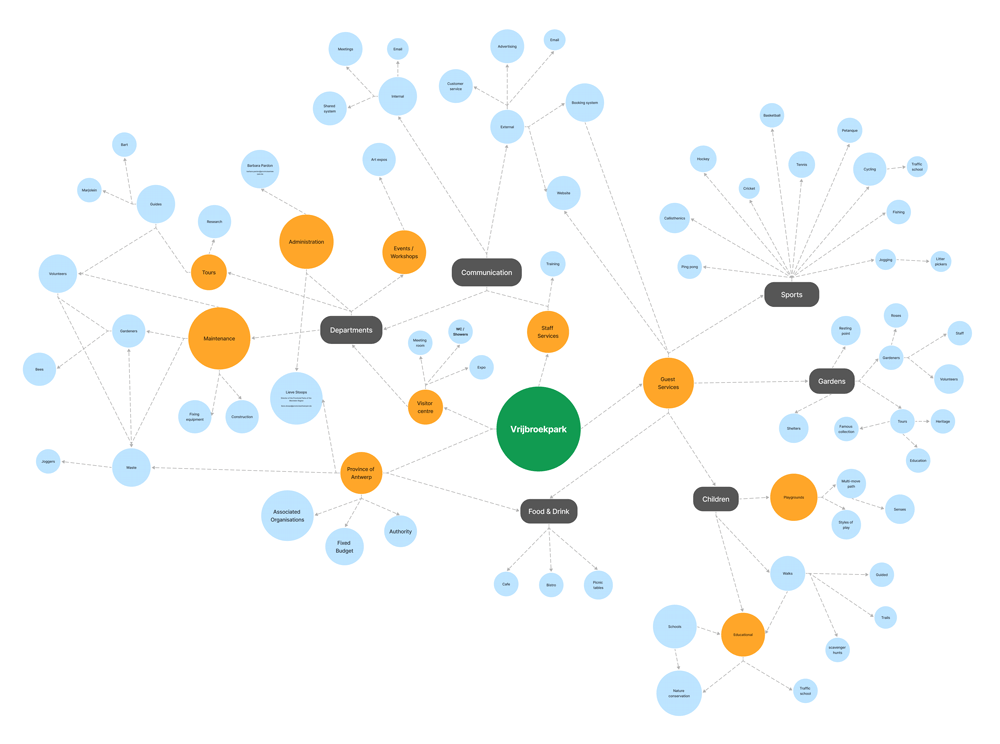
Site Gigamap
Visualising links between users, services, and staff revealed interconnected categories within the organisation. Embracing a systems-thinking approach offered a holistic view of the park’s ecosystem, highlighting networks and opportunities for collaboration.
Data was also analysed using affinity maps to identify themes and findings.
Key Insights & Future Vision:
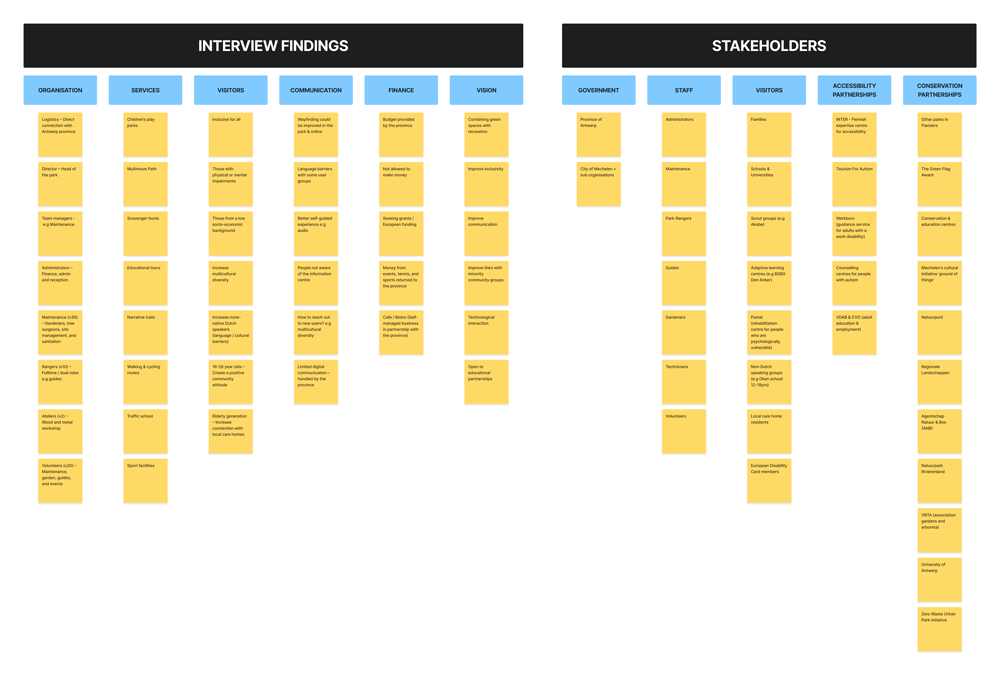
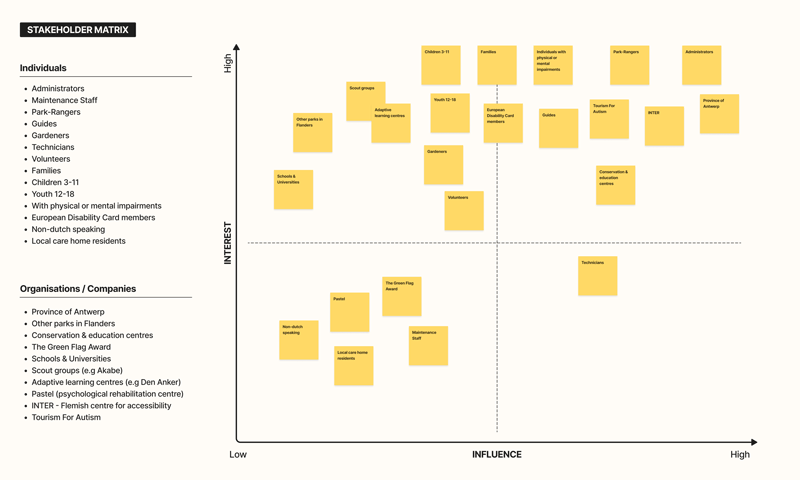
Stakeholder Matrix
Using a matrix framework, we organised the stakeholders based on their perceived level of influence and interest concerning the project. This enabled us to identify relevant specialists we could approach to validate concepts during the later stages of development. This process highlighted the importance of on-site staff responsible for implementing, utilising and improving park services. Additionally, we were able to determine individuals and organisations with proven expertise working with underrepresented visitors, including those with physical and cognitive impairments.
Through research and exploration of the park’s current offerings, we identified a compelling need to enhance the accessibility of the multi-move path. As a service, it resonates with the core mission of the park including connection with nature, immersive unstructured play, child development, and versatile experiences, in addition to championing the use of sustainable on-site materials. With a focus on creating engaging play experiences for every individual, irrespective of their physical capabilities, we formed the problem statement:
Problem Statement
‘How can we reimagine the multi-move path to be more accessible to people with varying levels of mobility?’
We then set about defining target users and creating personas to guide the design process. As a public service, we were keen to explore a cross-section of visitor wants and requirements, in doing so we refined our focus based on mobility, cognitive, and visual impairments. Subsequently, it was also important to consider the needs of older users currently not being addressed, and of staff members maintaining and facilitating play. Guided by universal design principles, our aim was to uncover similarities in user needs, including permanent, temporary, or situational impairments, in order to design for a wider user base. When addressing mobility barriers, parallels emerged between wheelchair users and parents with buggies, particularly in terms of access and usability. Our research also highlighted shared characteristics and requirements between those with hearing loss and autism, specifically around awareness and physical safety.
Define
Design Challenge • Priority Chart • User Journey • Future Stakeholder Map
Universal Design
Accessibility Needs • Senses & Immersive Experiences
Participatory Design
Teams came together to organise and facilitate a public workshop to further research and validate project development with key stakeholders.
Service Solutions
Concept Designs • Accessible touchpoints enabling a pre-service, service & after-service
Goal
Our primary objective in conducting the participatory session was to gather valuable insights and feedback from expert stakeholders concerning the relevance of our project’s focus. In doing so we set out to gain a deeper understanding of future user’s needs and values, while enabling us to validate assumptions and collaborate on further ideation.
Participants
We invited attendees with first-hand experience working with our target users, park services and conservation projects. This included disability support workers and care providers, park rangers, municipal officials, accessibility advocates, youth group leaders, school teachers, international students, park volunteers, and visitors from the general public.
Toolkit
To unify the various themes addressed by the four design teams, we developed a canvas comprising the following categories underpinning the development of each project: Environment, Communication, Interaction, and Facilities. Each canvas was designed to showcase each team’s unique problem statement and visualised concept.
Process
Throughout the session, two designated representatives from each design team (myself included) facilitated breakout groups, engaging participants in discussions and ideation around their design challenge. Each session lasted 20 minutes before participants rotated to the next team. After the forth round, data was collated and reorganised into a prioritising chart. During this final stage, participants were tasked with ranking the generated ideas and suggestions based on their perceived significance and potential future value.
Design Challenge
‘How can we enable under-represented visitors to connect with the natural environment through accessible and immersive experiences?’
Senses & Immersive Experience
To address the need for accessible play services in the park, we embraced universal design thinking, making inclusivity a core principle. Our approach, centred on the bodily senses, aimed to ensure that our concept solutions deliver sensory-rich experiences for all visitors, accommodating diverse abilities and needs. Guided by research highlighting the benefits of unstructured play in nature, we sought to heighten visitors’ awareness of their surroundings. Through this sensory lens, our proposal featured service touchpoints and environments where touch, sight, sound, and smell converge to create interactive play stations. In doing so, we not only addressed the need for inclusive play but also provided educationally enriching experiences aligning with the park’s ongoing conservation efforts and sustainability goals.
‘Multi-Sensory For Everyone’ provides immersive and educational play experiences in public parks. Designed for all, these interactive installations challenge users to fully utilise their senses and connect with the natural world. By framing nature this way the path presents a range of mindful activities to help visitors learn about and engage with their surroundings.
Our proposed service is designed with a range of accessibility needs in mind. Drawing from the ‘Wheel of Inclusion’ framework developed by Ann Bosserez and fellow researchers at Thomas More University, we looked at how touchpoints would address fundamental principles of inclusive design in making sure they were reachable, understandable, usable, trustable, and affordable.
While initial site mapping highlighted the extent of inaccessible play spaces and services, it was equally important for us to make sure solutions would be effective in being easily understood without the need for supervision, or detailed explanation.
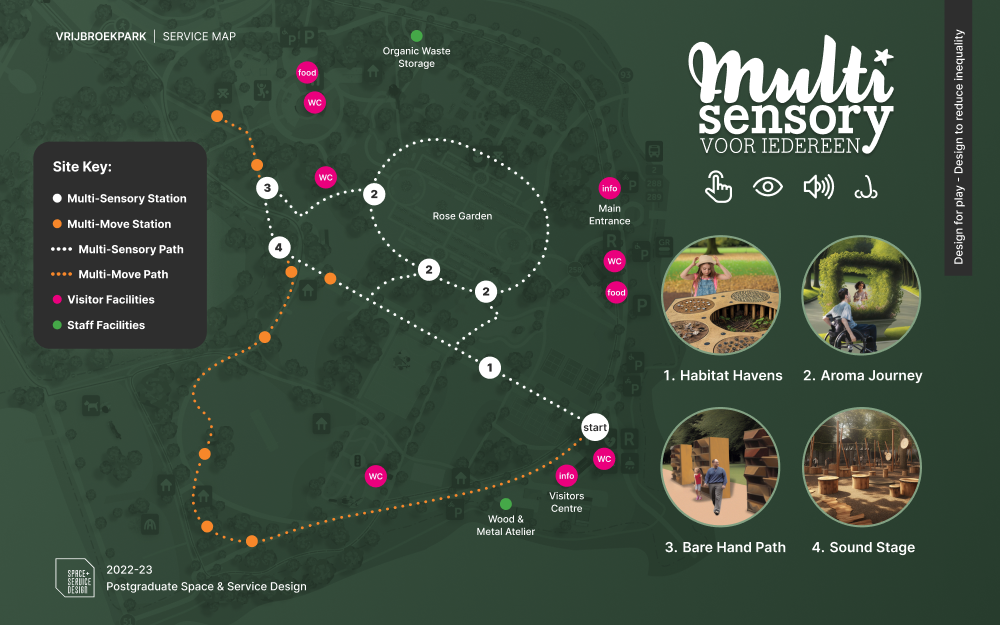
Site Map
The Multi-sensory pathway is purposefully located near the car parks and utilises paved surfaces to ensure year-round access for all visitors. Alongside the existing Multi-move path, the newly established play network improves access to essential public amenities and support services, including the visitor’s centre, eateries, toilets, seating areas, and picnic benches. The new pathway invites guests to discover lesser-explored areas of the park, such as the gardens, encouraging greater social cohesion and enriching the overall park experience.
